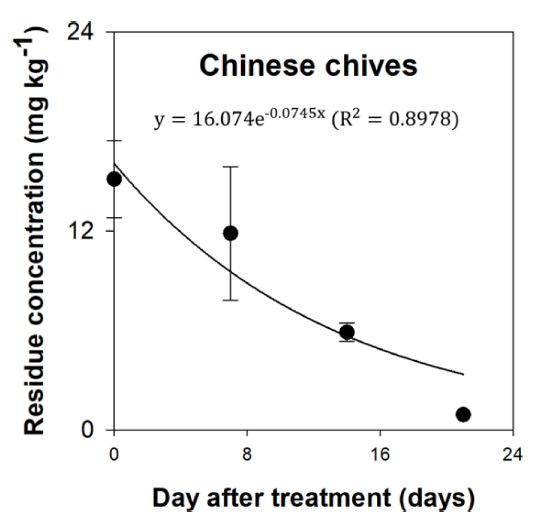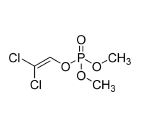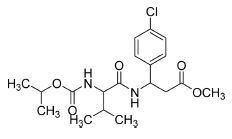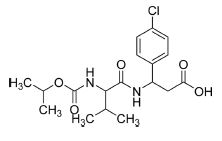
시설재배 부추 중 Dichlorvos와 Valifenalate 사용에 따른 경시적 잔류량 변화와 잔류 안전성 평가
 ; Ji-Yeon Bae1, †
; Ji-Yeon Bae1, † ; Yeong Hun Song1
; Yeong Hun Song1 ; Kyeong-Yeol Oh1
; Kyeong-Yeol Oh1 ; Yeong-Jin Kim1, 2
; Yeong-Jin Kim1, 2 ; Dong-Yeol Lee3
; Dong-Yeol Lee3 ; Jin-Hyo Kim1, *
; Jin-Hyo Kim1, *
초록
부추 시설재배지에 20% dichlorvos 유제와 12% valifenalate 액상수화제를 살포하여 이들의 경시적 잔류변화와 생물학적 반감기 및 잔류 안전성을 평가하였다. 수확 당일 약액 살포 후 dichlorvos의 초기 잔류량은 1.709-2.054 mg kg-1이었으나, 이를 제외한 모든 시료에서 dichlorvos는 LOQ미만으로 불검출 되었으며, 20% dichlorvos 유제를 수확 7일 전까지 2회 처리하여도 잔류안전성에는 큰 영향이 없을 것으로 판단되었다. Valifenalate의 총 환산잔류량은 수확 당일 약액 살포 후 13.06-17.63 mg kg-1이었고, 최종 약제 처리 21일 경과 후 잔류량은 0.891-0.955 mg kg-1으로 감소함을 확인하였고, 이는 현재 부추에 설정되어 있는 최대 잔류 허용량인 0.05 mg kg-1을 초과하지 않았다. Valifenalate에 대한 부추의 생물학적 반감기는 9.30일이었다. 따라서, 12% valifenalate 액상수화제를 수확 14일 전까지 2회 처리하여도 잔류안전성에는 큰 영향이 없을 것으로 판단되었다.
Abstract
The residual dissipation pattern, the biological half-lives, and residual safety of dichlorvos and valifenalate were investigated on Chinese chives under greenhouse conditions. The tested pesticides were 20% dichlorvos (EC) and 12% valifenalate (SC), which were sprayed on Chinese chives at 7 days intervals and twice before the harvest day. The residues of dichlorvos in Chinese chives were detected ranged from 1.709 to 2.054 mg kg-1 on 0 days-after-treatment (DAT), but it was not detected after 7 DAT. Thus, 20% dichlorvos (EC) would be available for treatment at 7 days intervals with twice applications before the harvest day without residue risk. The residues of total valifenalate in Chinese chives were detected ranged from 13.06 to 17.63 mg kg-1 on 0 DAT, and the residues were decreased to 0.891-0.955 mg kg-1 on 21 DAT. The residues of valifenalate did not exceed the currently established maximum residue limit (MRL) 20 mg kg-1 on Chinese chives. The half-life of valifenalate in the Chines chives was 9.30 day. Thus, 12% valifenalate (SC) would be available for the twice treatment with 7 days intervals before 14 days on the harvest.
Keywords:
Biological half-life, Chinese chives, Dichlorvos, Valifenalate, Residual safety키워드:
디클로르보스, 발리페날레이트, 생물학적 반감기, 잔류안전성, 부추서 론
1인 가구의 확대와 맞벌이 가구의 증가, 편리성을 중시하는 식품소비 트렌드의 확산에 따라 섭취가 용이한 컵과일, 샐러드 등 즉석섭취용 신선편이 과일과 채소에 대한 소비자의 관심이 높아지고 있다(KREI, 2019). 또한, 2020 농식품 소비정보 분석사업 결과 농식품 구매 시 고려하는 특성 중 건강과 안전성이 각각 29.1%와 27.3%로 가장 높았다(KREI, 2020). 소면적 작물은 엽채류와 엽경채류, 산채류 등이 포함되어 있으며, 신선채소의 소비 증가에 따라 재배면적이 증가하고 있다(Woo et al., 2015). 하지만, 국내에서 재배되는 소면적 작물들은 외국에서 도입되거나 재배 역사가 짧아 재배기술이 확립되어 있지 않고, 등록농약이 제한되어 있어, 병해충 발생과 같은 피해가 심각한 실정이다(Son et al., 2012; Kim et al., 2017b). NAQS (2017)의 농산물 품목별 유해물질 조사 결과에 따르면, 대파, 미나리, 부추, 케일, 파세리 등 13종 엽채류 소면적 작물의 잔류농약의 부적합 비율이 48.7%로 높았다. 또한, 2019년부터 모든 농산물에 대해 농약 허용물질목록 관리제도(Positive List System, PLS)가 시행됨에 따라 등록농약 수가 적은 소면적 작물에 사용 가능한 농약 등록이 필요한 실정이다.
엽경채류인 부추의 국내 재배면적은 1,572 ha이며, 이 중 시설재배 부추의 면적은 1,123 ha으로, 국내에서 부추는 대부분 시설에서 재배하고 있다(KOSIS, 2022). 시설재배는 시설 내의 높은 온도와 습도 등 환경에 의해 살포된 농약의 분해 및 휘발이 발생할 수 있다(Kim et al., 2017a). 국내에서 재배되는 부추(Allium tuberosum R.)는 1회 파종으로 5-6년간 연속 수확이 가능하며, 1년에 8-10회 수확할 수 있다. 부추에는 클로로필, 카로틴, 비타민 C, 칼슘, 철분, 식이 섬유소 등의 영양소가 많이 함유되어 있으며, 주로 겉절이나 무침, 전으로 섭취한다(Moon et al., 2003; An et al., 2019).
부추의 주요 발생 병해는 균핵병, 노균병, 무름병, 잎마름병, 흑색썩음균병, 잿빛곰팡이병, 흰가루병 등 8종이 있으며, 해충은 거세미나방, 고자리파리, 꽃노랑총채벌레, 뿌리응애, 뿌리혹선충, 파밤나방, 파혹진딧물 등 18종이 있다. 이들 병해충 방제를 위한 여러 농약이 부추에 대해 등록되어 있으나, 저항성발현 억제와 병해충 효율을 높이기 위한 다양한 유효 성분에 대한 수요가 꾸준히 제기되고 있다(Lee et al., 2021).
유기인계 농약인 dichlorvos는 아세틸콜린에스터라제 기능 저해제로, 20% dichlorvos 유제는 배추와 파의 파밤나방, 배추의 배추좀나방, 복숭아와 사과의 썩덩나무노린재 등의 해충 방제에 등록되어 사용되고 있다(KCPA, 2022). 발리나 마이드카바메이트계 농약인 valifenalate는 세포벽 생합성 제해제로, 12% valifenalate 액상수화제는 양파, 오이, 참외, 포도, 배추, 멜론, 시금치 등 8종 작물의 노균병 방제에 등록되어 사용되고 있다(KCPA, 2022).
농약의 잔류량은 대상 농약의 이화학적 특성, 재배조건, 광분해, 비대성장에 따른 희석효과 등의 여러 요인 뿐만 아니라, 작물의 형태와 작물 표면의 물리적 특성에 의해 영향을 받을 수 있으므로, 작물에 따른 농약의 잔류량을 검토할 필요가 있다(Son et al., 2012; Jin et al., 2018). 부추에 대한 dichlorvos와 valifenalate의 최대잔류허용기준(Maximum residue limit, MRL)은 각각 0.05mg kg-1과 20 mg kg-1으로 설정되어 있으나(MFDS, 2022), 부추의 파밤나방 방제와 노균병 방제를 위한 이들 농약의 안전사용기준은 설정되어 있지 않다. 이에 따라, 본 연구에서는 부추 시설재배지에서 20% dichlorvos 유제와 12% valifenalate 액상수화제를 살포하여 이들의 경시적 잔류변화를 평가하고, 생물학적 반감기와 잔류 안전성을 검토하였다.
재료 및 방법
표준품 및 시약
Dichlorvos와 valifenalate의 분석용 표준품은 Kemidas Co. (Suwon, Korea)에서 구입하여 사용하였고, valifenalate의 대사체인 IR5839는 Isagro Ricerca S.R.L (Milan, Italy)의 표준품을 AB Solution Co., Ltd. (Hwaseong, Korea)로부터 제공받아 사용하였으며, 시험대상 성분의 이화학적 특성은 Table 1과 같다.
잔류분석시험에 사용한 용매인 acetonitrile (ACN)과 methanol, water는 Burdick & JacksonTM (Honeywell International Inc, Morris Plains, NJ, USA)의 high-performance liquid chromatography (HPLC) grade를 사용하였고, ammonium acetate (Sigma-Aldrich, Inc., St. Louis, MO, USA)와 formic acid (MerckKGaA, Darmstadt, Germany)는 순도>98%를 사용하였다. 부추 중 dichlorvos의 추출에 사용한 magnesium sulfate (MgSO4), sodium chloride (NaCl)는 MerckKGaA (Darmstadt, Germany)에서 구입하여 사용하였고, 추출시료의 정제를 위한 dispersive-solid phase extraction (d-SPE)는 primary secondary amine (PSA) 25 mg과 MgSO4 150 mg으로 구성된 Agilent Technologies, Inc. (Santa Clara, CA, USA)의 d-SPE kit와 Supelclean ENVI-CarbTM (Supelco®, Sigma-Aldrich, Inc., Bellefonte, PA, USA)를 사용하였다. 부추 중 valifenalate와 이의 대사체인 IR5839의 추출은 Agilent Technologies, Inc. (Santa Clara, CA, USA)의 QuEChERS extraction kit (EN15662 method, 4 g MgSO4 anhydrous, 1 g NaCl, 1 g sodium citrate tribasic dihydrate 및 0.5 g sodium citrate dibasic sesquihydrate)를 사용하였고, 추출시료의 정제는 C18 30 mg, MgSO4 150mg으로 구성된 Agilent Technologies, Inc. (Santa Clara, CA, USA)의 d-SPE kit를 사용하였다.
시험포장 및 약제 처리
부추에 대한 dichlorvos의 잔류시험은 20% dichlorvos와 10% etofenprox 혼합제인 유제(NongHyup Chemical Co., Ltd., Seongnam, Korea)를 사용하였고, valifenalate의 잔류시험은 12% valifenalate 액상수화제(SG HANKOOK SAMGONG Co., Ltd., Seoul, Korea)를 사용하였다. 부추의 잔류성시험은 경상남도 진주시 대곡면 와룡리에 소재한 시설재배지에서 3월부터 4월까지 실시하였고, 품종은 슈퍼그린벨트(Asia Seed Co., Seoul, Korea)를 사용하였다. 잔류시험포장의 대조구는 10m2 (2.0m× 5.0m)로 조성하였으며, 시험구는 각각 36m2 (2.0m× 18m)로 조성하여 시험구별 3반복 배치하였고, 시험구의 시험 약제 간 교차오염 방지를 위해 3.0m 이상의 완충구를 두었다. 시험 약제는 1,000배 희석하여 충전식 분무기로 시험구 전체에 약액이 충분히 흐를 정도로 균일하게 살포하였다. 약제 살포일은 부추 수확일을 기준으로 7일간격 2회 살포하였고(Table 2), 부추 시료는 최종 약제 살포 후 일시 수확하였다. 재배기간 동안 시설 재배지의 평균 온도는 18.0oC (2.7-43.9oC), 평균 상대습도는 86% (15-99%)이었다. 잔류분석을 위한 시료는 수확 당일 처리구별 최소 1 kg 이상 수확하였으며, 수확한 시료는 냉장상태로 실험실로 옮긴 후 드라이아이스와 함께 곱게 분쇄하고 잔류분석 전까지 -20oC에서 보관하였다.
잔류분석 시료 전처리
부추 중 dichlorvos의 잔류분석을 위한 시료 전처리는 균질화한 시료 10.0 g에 A CN 10.0mL를 가한 후 MgSO4 4 g과 NaCl 1g을 첨가하여 30분간 진탕 및 초음파 추출(Powersonic 410, Hawshin Tech Co., Ltd., Seoul, Korea)하였다. 추출시료는 4oC, 4000 rpm에서 10분간 원심분리(LABOGENE 1580R, LabogenTM, Bio-Medical Science Co., Ltd., Seoul, Korea)하고, 상등액 1mL를 취하여, PSA 25 mg과 MgSO4 150 mg, ENVI-CarbTM 25mg이 담긴 etube에 넣고 3분간 vortexing한 후 syringe filter (PTFE, 0.22 μm, BIOFACT Co., Ltd., Daejeon, Korea)로 여과하여 잔류분석용 시료로 제조하였다. 부추 중 valifenalate와 이의 대사체인 IR5839의 잔류분석을 위한 시료 전처리는 균질화한 시료 10.0 g에 A CN 1 0.0mL를 가한 후 QuEChERS extraction kit를 첨가하여 30분간 진탕 및 초음파 추출하였다. 추출시료는 4oC, 4000 rpm에서 10분간 원심분리하고, 상등액 1mL를 취하여 C18 30mg과 MgSO4 150mg이 담긴 d-SPE kit에 넣고 3분간 vortexing한 후 syringe filter로 여과하고, 여과액을 80% ACN으로 2배 희석하여 잔류분석용 시료로 제조하였다.
기기분석 조건
부추 중 dichlorvos와 valifenalate 및 이의 대사체인 IR5839의 잔류분석은 LC-MS/MS (Agilent Technologies 6420 TripleQuad, Santa Clara, CA, USA)를 사용하여 Table 3의 조건에 따라 분석하였다. 이동상 용매는 5mM ammonium acetate를 포함한 0.1% formic acid 수용액과 5 mM ammonium acetate와 0.1% formic acid를 포함한 methanol을 사용하였고, Waters Corporation. (Milford, MA, USA)의 AccQ-Tag Ultra C18 (2.1 × 100 mm, 1.7 μm) 칼럼을 사용하여 분리하였다.
분석법 검증
Dichlorvos와 valifenalate 및 이의 대사체인 IR5839의 검량선 작성을 위해 사용한 농약 표준품은 100mg L-1 stock solution을 제조한 후 무처리 부추 시료의 추출물로 희석하여 matrix-matched standard를 제조하였다. Dichlorvos와 valifenalate, IR5839의 검량선은 0.005-0.50 mg kg-1의 범위에서 작성하였으며, 정량한계(Limit of quantitation, LOQ)는 signal/noise비 10이상을 기준으로 산출하였고(Lee et al. 2015), 회수율 시험은 0.02 mg kg-1과 0.2mg kg-1에서 5반복 수행하였다.
Valifenalate의 총 환산잔류량
대사체를 포함하는 농약의 유효성분인 valifenlate의 총 환산잔류량은 농촌진흥청의 “농약의 잔류분 정의” 지침에 따라(NAS, 2018), 대사체의 환산계수를 활용하여 산출하였다(Eq. 1).
Valifenalate의 총 환산잔류량;
| (Eq. 1) |
생물학적 반감기 산출
생물학적 반감기 산출은 Kong et al. (2018)과 Lee et al. (2020)이 사용한 방법에 따라 약제 처리 후 경과일수에 따른 잔류량 변화에 대한 회귀식은 Eq. 2에 적용하여 산출하였고, 반감기(DT50)는 Eq. 3를 사용하여 산출하였다.
| (Eq. 2) |
| (Eq. 3) |
잔류 안전성 평가
Dichlorvos와 valifenalate의 잔류 안전성 평가를 위한 이론적 1일최대섭취량(Theoretical maximum daily intake, TMDI)은 2019년 국민영양통계 중 전체 연령의 식이 섭취량 자료와 평균 체중(61 kg) 및 식품의약품안전처(Ministry of Food and Drug Safety, MFDS)의 잔류물질정보에 등록되어 있는 MRL을 Eq. 4에 적용하여 산출하였다(KHIDI, 2019; Lee et al. 2021). %ADI는 MFDS의 잔류물질정보에 등록되어 있는 1일섭취허용량(Acceptable daily intake, ADI)과 산출한 TMDI를 Eq. 5에 적용하여 산출하였다.
| (Eq. 4) |
| (Eq. 5) |
결과 및 고찰
분석법 검증
부추 중 dichlorvos와 valifenalate 및 이의 대사체인 IR5839의 잔류분석을 위한 검량선의 linearity (R2)는 모두 0.999 이상이었고, 부추에서 분석 대상 성분의 LOQ는 dichlorvos가 0.005mg kg-1이었고, valifenalate와 IR5839는 0.01mg kg-1이었다. 부추에서 dichlorvos와 valifenalate, IR5839의 회수율은 0.02 mg kg-1와 0.20 mg kg-1에서 시험하였다. 그 결과 dichlorvos의 평균 회수율은 102.7-106.1%이었으며, valifenalate는 86.8-116.3% 이었고, IR5839는 104.3-114.4%이었다. 이들 정량분석에 대한 변이계수(Coefficient of variation, CV)는 0.9-5.5%이었다(Table 4).
부추 중 dichlorvos의 경시적 잔류 변화와 잔류 안전성 평가
20% Dichlorvos와 10% etofenprox의 혼합제는 파에서 파밤나방 방제에 사용 시 1,000배 희석액을 수확 7일전까지 3회 이내 사용할 수 있도록 안전사용기준이 설정되어 있다(KCPA, 2022). 이에 따라, 본 연구에서는 20% dichlorvos와 10% etofenprox 혼합제 1,000배 희석액을 7일간격 2회 살포 후 부추에서 dichlorvos의 잔류량을 조사하였다. 수확 당일 약액 살포 후 dichlorvos의 초기 잔류량은 1.709-2.054 mg kg-1이었으나, 약액 살포 당일을 제외한 모든 시료에서 dichlorvos는 LOQ미만으로 불검출 되어 부추에서 dichlorvos의 잔류 반감기는 7일 이내로 추정되었다(Table 5). 유기인계 농약은 증기압이 높으며(6.02 × 10-2-7.67 × 103mPa), 작물에서의 반감기는 7일 이내로 보고되었다(IUPAC, 2022). 타 작물에서 dichlorvos의 작물 잔류 반감기는 오이와 양배추에서 1.2-3.5일로 길지 않았으며(Li et al., 2011; Liang et al., 2012), 이는 유기인계 농약인 dichlorvos의 높은 증기압에 따른 휘발손실의 결과로 판단되었다(EPA, 2006).

Time-course residue and half-lives of dichlorvos, valifenalate, and IR5839 in Chinese chives (Allium tuberosum R.)
Dichlorvos는 49종의 작물에 MRL이 설정되어 있으며, 부추에 대한 dichlorvos의 MRL은 0.05mg kg-1으로 설정되어 있다(MFDS, 2022). 이에 따른 전체 작물의 TMDI는 4.26 × 10-4mg kgbw-1 day-1로 ADI (0.004 mg kgbw-1 day-1)의 10.6%이었으며, 부추에 설정된 MRL의 % A DI는 0.05%로 높지 않았다. 따라서, 수확 당일 약액 살포 처리구를 제외한 모든 처리구에서 dichlorvos가 불검출 되었으므로, 부추에 대한 20% dichlorvos 유제의 안전사용기준은 수확 7일 전까지 2회 처리로 고려해볼 수 있을 것이다.
부추 중 vailfenalate의 경시적 잔류 변화와 잔류 안전성 평가
12% Valifenalate는 노균병 방제에 사용 시 배추와 시금치에서 각각 수확 21일전 2회 이내와 수확 7일전 2회 이내로 사용할 수 있도록 안전사용기준이 설정되어 있다(KCPA, 2022). 이에 따라, 본 연구에서는 12% valifenalate를 1,000배 희석하여 7일간격 2회 살포 후 부추에서 valifenalate의 잔류량을 조사하였다. 수확 당일 약액 살포 후 모화합물인 valifenalate와 이의 대사체인 IR5839의 초기 잔류량은 12.7-17.18 mg kg-1 와 0.353-0.443 mg kg-1이었고, 최종 약제 처리 21일 경과 후 valifenalate와 IR5839의 잔류량은 0.860-0.910 mg kg-1 와 0.029-0.043 mg kg-1으로 검출되었다(Table 5). 모화합물과 대사체의 잔류량을 적용하여 산출한 valifenalate의 총 환산잔류량은 약액 처리 당일 초기 잔류량은 13.06-17.63 mg kg-1이었고, 최종 약제 처리 21일 경과 후 잔류량은 0.891-0.955 mg kg-1으로 감소함을 확인하였다. Valifenalate에 대한 부추의 생물학적 반감기는 9.3일로 산출되었고(Fig. 1), 이는 과채류인 포도(15.5일)의 반감기 보다는 짧았다(Li et al., 2019). Valifenalate와 작용기작이 동일한 dimethomorph의 쪽파 중 반감기는 7.0-7.5일로 보고되었으며(Park et al., 2012), 이는 부추에서의 반감기(9.3일) 보다 짧았다.
현재 valifenalate는 37종의 작물에 MRL이 설정되어 있으며, 전체 작물의 TMDI는 8.22 × 10-3mg kgbw-1 day-1로 ADI(0.07 mg kgbw-1 day-1)의 11.8%이었으며, 부추에 설정된 MRL(20 mg kg-1)의 %ADI는 1.22%로 높지 않았다. Valifenalate의 최종 약액 처리 7일 경과 후 총 환산잔류량은 부추에 대해 현재 설정된 MRL을 초과하지는 않았으나, 최대 16.17 mg kg-1으로 설정된 MRL과 유사하게 검출되었다. 따라서, 부추에 대한 12% valifenalate 액상수화제의 안전사용기준은 수확 14일 전까지 2회 처리로 고려해볼 수 있을 것이다.
작물의 형태적 특성에 따른 dichlorvos와 valifenalate의 잔류량 비교
작물의 재배과정 중에 살포된 농약의 작물 잔류량은 처리 약제의 물리화학적 특성과 재배조건, 광분해, 약제처리 방법, 약제살포 후 경과일수 및 비대생장에 의한 희석효과 등에 의한 영향 외에도 작물 잎의 형태와 비표면적, 미세한 털의 유무 등의 형태적 특성에 의해 영향을 받는다고 보고된 바 있다(Ambrus, 2000; Lee et al., 2003; Ripley et al., 2003; Jin et al., 2018; An et al., 2019). 부추와 호박 잎에서 20% dichlorvos 유제 살포 후 초기 잔류량은 각각 1.90mg kg-1과 0.982 mg kg-1으로, 부추에서의 초기 잔류량이 호박 잎의 초기 잔류량보다 약 2배가량 높았다(Table 6). 부추와 호박 잎에서의 dichlorvos의 잔류량은 약액 살포 당일을 제외한 모든 시료에서 LOQ미만으로 불검출 되었다(Table 5) (Lee et al., 2021). 호박 잎은 잎 너비가 넓고 펼쳐져 있으며, 부추는 잎 너비가 좁고 길며, 균일하게 뻗어 있다(An et al., 2019). 단위 무게당 표면적은 호박잎이 2배가량 높으나, 호박 잎 뒷면에 주로 존재하는 미세한 털과 살포액의 높은 표면장력이 작물 부착성을 낮추어 호박 잎의 잔류량이 부추보다 낮은 것으로 추정된다(Jin et al. 2018).
엽경채류인 부추와 엽채류인 상추, 결구 엽채류인 엇갈이 배추에서 12% valifenalate 액상수화제 살포 후 초기 잔류량은 각각 15.1 mg kg-1과 9.79 mg kg-1, 5.79 mg kg-1이었다(Table 6). Valifenalate의 초기 잔류량은 부추에서 가장 높았으며, 이는 상추의 초기 잔류량 보다 약 1.5배 높았고, 엇갈이배추의 초기 잔류량 보다 약 3배 높았다. 본 연구에서 사용한 액상수화제는 부착성과 고착성이 탁월하여 작물체에 대한 농약 부착에 많은 영향을 줄 수 있다고 보고된 바 있으며(Hwang et al., 2017), 부추의 형태 특성상 잎이 길고 균일하게 뻗어 있어 약제의 상당부분이 엽면에 부착됨에 따라 초기 잔류량에 영향을 미칠 수 있다고 보고된 바 있다(An et al., 2019). 엽채류인 상추에서 valifenalate의 초기 잔류량은 결구 엽채류인 엇갈이배추 보다 약 1.7배 높았으며, 이는 엽채류가 결구 엽채류보다 부피에 대한 노출 표면적 비율이 높아 농약 잔류가 높다고 보고된 결과와 유사하였다(Ripley et al., 2003). 이에 따라, 농약 살포 후 초기 잔류량은 환경적 요인 이외에도 작물의 형태가 영향을 미칠 수 있다고 판단할 수 있었다.
Acknowledgments
This study was supported by the “Research Program for Agricultural Science & Technology Development (Project No. PJ01449602)”, National Institute of Agricultural Sciences, Rural Development Administration, Republic of Korea.
References
-
Ambrus A, 2000. Within and between field variety of residue data and sampling implications. Food Addit. Contam. 17(7):512-537.
[https://doi.org/10.1080/026520300412410]

-
An JM, Kim IR, Kim MK, Chang SY, Lim JH, et al., 2019. Residual characteristic of fungicide tebuconazole in Chinese chives (Allium tuberosum R.) under greenhouse condition. Korean J. Pestic. Sci. 23(3):220-230. (In Korean)
[https://doi.org/10.7585/kjps.2019.23.3.220]

-
Hwang EJ, Park JE, Do JA, Chung HW., Chang HR, et al., 2017. Residual dissipation based on crop commodities classification of boscalid and spinetoram on crown daisy and sweet pepper under green houses. Korean J. Environ. Agri. 36(3):184-192. (In Korean)
[https://doi.org/10.5338/KJEA.2017.36.3.29]

- International Union of Pure and Applied Chemistry (IUPAC), 2022. IUPAC Pesticide Properties DataBase. http://sitem.herts.ac.uk/aeru/iupac/atoz.htm, (Accessed Feb. 19. 2022).
-
Jin MJ, Park HK, Jeong HR, Lee JW, Jo SH, et al., 2018. Residual characteristics and safety assessments of the fungicide fenhexamid in some minor crops. Korean J. Pestic. Sci. 22(4):363-369. (In Korean)
[https://doi.org/10.7585/kjps.2018.22.4.363]

-
Kim HG, Kim JY, Hur KJ, Kwon CH, Hur JH, 2017a. Establish of pre-harvest residue limit (PHRL) of flubendiamide and pyriofenone on strawberry (Fragaria ananassa Duch.). Korea J. Pestic. Sci. 21(1):62-67. (In Korean)
[https://doi.org/10.7585/kjps.2017.21.1.62]

-
Kim YH, Yoo JK, Hong SI, Lee JY, Ryu GH, et al., 2017b. Comparison of the three insecticides efficacy against turmip aphid (Lipaphis erysimi) and cabbage aphid (Brevicoryne brassicae) in the crucifer crops. Korean. J. Pestic. Sci. 21(3):284-288. (In Korean)
[https://doi.org/10.7585/kjps.2017.21.3.284]

-
Kong SH, Lee DY, Song YH, Park KH, Seo WD, et al., 2018. Residue safety on ethephon in soybean leaf by drenching and foliar application. J. Appl. Biol. Chem. 61(1):75-78. (In Korean)
[https://doi.org/10.3839/jabc.2018.011]

- Korea Crop Protection Association (KCPA), 2022. Agrochemical use guide book. https://www.koreacpa.org/ko/use-book, / (Accessed Feb. 19. 2022).
- Korea Health Industry Development Institute (KHIDI), 2019. Korea National Health & Nutrition Examination Survey. https://www.khidi.or.kr/kps/dhraStat/result2?menuId=MENU01653&gubun=&year=2019, (Accessed Feb. 19. 2022).
- Korean Statistical Information Service (KOSIS), 2022. Vegetable Production (Fruit Vegetables). https://kosis.kr/statisticsList/statisticsListIndex.do?publicationYN=Y&statId=1975021#K1_27.2, (Accessed Feb. 19. 2022).
- Korea Rural Economic Institute (KREI), 2019. Research on Fresh-cut Fruits and Vegetables. Naju, Korea. p. 85-131.
- Korea Rural Economic Institute (KREI), 2020. Research Service for Food Consumption. https://www.krei.re.kr/consumptioninfo/index.do, (Accessed Feb. 19. 2022)
-
Lee DY, Bae JY, Oh KY, Ryu SK, Kim YJ, et al., 2021. Residual safety of boscalid, fluxapyroxad, hexaconazole, pencycuron, pyraclostrobin, and thifluzamide as fungicides for the prevention of Sclerotinia Rot on carrot. Korean J. Pestic. Sci. 25(1):11-19. (In Korean)
[https://doi.org/10.7585/kjps.2021.25.1.11]

-
Lee YJ, Ko KY, Won DJ, Gil GH, Lee KS, 2003. Residue patterns of procymidone, chlorpyrifos and cypermethrin in peaches during cultivation and storage period. Korean J. Environ. Agric. 22(3):220-226. (In Korean)
[https://doi.org/10.5338/KJEA.2003.22.3.220]

-
Li W, Ma Y, Li, L, Qin DM, Wu YJ, 2011. The dissipation rates of trichlorfon and its degradation product dichlorvos in cabbage and soil. Chemosphere. 82(6):829-833.
[https://doi.org/10.1016/j.chemosphere.2010.11.027]

-
Li R, Chen Z, Tao Y, Pan X, Jiang D, et al., 2019. Determination of valifenalate in grape, vegetables, and soil using ultrahigh performance liquid chromatography tandem mass spectrometry and exploration of its degradation behavior in grape field. Food Anal. Method. 12:742-751.
[https://doi.org/10.1007/s12161-018-1399-3]

-
Liang Y, Wang W, Shen Y, Liu Y, Liu XJ, 2012. Dynamics and residues of chlorpyrifos and dichlorvos in cucumber grown in greenhouse. Food Control. 26(2):231-234.
[https://doi.org/10.1016/j.foodcont.2012.01.029]

- Ministry of Food and Drug Safety (MFDS), 2022. Pesticide and veterinary Drugs Information. https://www.foodsafetykorea.go.kr/residue/main.do, (Accessed Feb. 19. 2022).
- Moon GS, Ryu BM, Lee MJ, 2003. Components and antioxidative activities of Buchu (Chinese chives) harvested at different times. Korean J. Food. Sci. Technol. 35(3):493-498. (In Korean)
- National Institute of Agricultural Science (NAS), 2018. Pesticide residue definitions for agricultural products. Wanju, Korea. (In Korea)
- National Institute of Agricultural Science (NAS), 2019a. Crop Residue Analysis of Minor Crop for Pesticide Registration Authority to Establish the Post-Harvest Interval(PHI) and Maximum Residue Limit(MRL). Part 1. Wanju, Korea. p. 58-120.
- National Institute of Agricultural Science (NAS), 2019b. Crop Residue Analysis of Minor Crop for Pesticide Registration Authority to Establish the Post-Harvest Interval(PHI) and Maximum Residue Limit(MRL). Part 2. Wanju, Korea. p. 89.
- National Agricultural Products Quality Management Service (NAQS), 2017. 2016 Annual report for quality management of agricultural products. Gimcheon, Korea. p. 28-29.
-
Park JW, Kim TH, Chae S, Sim JR, Bae BJ, et al., 2012. The residue property of fungicide dimethomorph and pyraclostrobin in green onion under greenhouse condition. Korea J. Pestic. Sci. 16(4):328-335. (In Korea)
[https://doi.org/10.7585/kjps.2012.16.4.328]

-
Ripley BD, Ritcey GM, Harris CR, Denomme MA, Lissemore LI, 2003. Comparative persistence of pesticides on selected cultivars of specialty vegetables. J. Agric. Food Chem. 51(5):1328-1335.
[https://doi.org/10.1021/jf020139o]

-
Son KA, Im GJ, Hong SM, Kim JB, Ihm YB, et al., 2012. Comparison of pesticide residue in perilla leaf, lettuce and kale by morphological characteristics of plant. Korea J. Pestic. Sci. 16(4):336-342. (In Korean)
[https://doi.org/10.7585/kjps.2012.16.4.336]

- United States Environmental Protection Agency (EPA), 2006. Interim Reregistration Eligibility Decision for Dichlorvos (DDVP). Washington D.C. USA, p. 120-157.
-
Woo MJ, Hur KJ, Kim JY, Manoharan S, Kim SW, et al., 2015. Residue characteristic of tebuconazole and fludioxonil in Allium victorialis (Allium ochotense Prokh.). Korean J. Pestic. Sic. 19(4):354-360. (In Korean)
[https://doi.org/10.7585/kjps.2015.19.4.354]

Deuk-Yeong Lee, Department of Agricultural Chemistry, Institute of Agriculture and Life Science (IALS), Gyeongsang National University, Ph.D. student, http://orcid.org/0000-0001-6047-5276
Ji-Yeon Bae, Department of Agricultural Chemistry, Institute of Agriculture and Life Science (IALS), Gyeongsang National University, Master, http://orcid.org/0000-0003-4872-9143
Yeong Hun Song, Department of Agricultural Chemistry, Institute of Agriculture and Life Science (IALS), Gyeongsang National University, Postdoctoral researcher, https://orcid.org/0000-0003-4095-5621
Kyeong-Yeol Oh, Department of Agricultural Chemistry, Institute of Agriculture and Life Science (IALS), Gyeongsang National University, Ph.D. student, https://orcid.org/0000-0002-1699-4164
Yeong-Jin Kim, Department of Agricultural Chemistry, Gyeongsang National University, Ph.D. student; Environmental Chemistry Research Group, Korea Institute of Toxicology, Researcher, https://orcid.org/0000-0002-3926-9387
Dong-Yeol Lee, Anti-Aging Research Group, Gyeongnam Oriental Anti-Aging Institute, Researcher, https://orcid.org/0000-0003-1192-1932
Jin-Hyo Kim, Department of Agricultural Chemistry, Institute of Agriculture and Life Science (IALS), Gyeongsang National University, Professor, https://orcid.org/0000-0002-0341-7085



